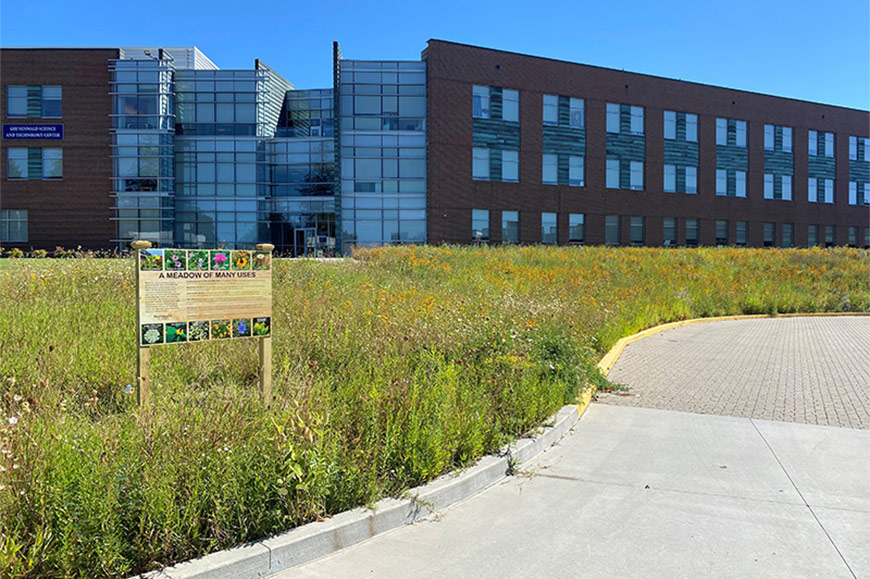On a warm, sunny day last fall, biology professor Dr. Andrew Turner led his class on a field trip. Sort of. They visited a wildflower meadow rather than a field, and the destination was mere steps outside of PennWest Clarion's Grunenwald Science and Technology Center.
The assignment was to collect and identify wildflowers. Students selected flowers that appealed to them and used an app to find their common and Latin names. Turner then pressed and cataloged the flowers to be used as an educational tool for future students.
More than an outdoor classroom, though, the meadow is meeting a crucial ecological need.
Meadows once were plentiful, but they’ve diminished in number in favor of property development. As meadows have disappeared, so have the bees, butterflies and birds that are essential to pollination. Without this ecological process, the world’s food supply is threatened. According to the U.S. Department of Agriculture, 35% of the world’s food crops depend on animal pollination: That’s one out of every three bites of food eaten.
For the past two decades, Clarion has adhered to a commitment of sustainability for new buildings and renovations. For the structures themselves, that has included choosing sustainable materials, using geothermal heat pumps, designing restrooms to conserve water, and installing motion-sensing lights.
The focus on sustainability extends to the landscaping.
In 2019, as the renovation of Tippin Gymnasium and Natatorium neared completion, the outside of the facility was being considered. In front of Tippin, native plant species create rain gardens that help to manage stormwater runoff. Between Tippin and the Grunenwald Center for Science and Technology, an intentional wildflower meadow is home to wildflowers and habitat for the insects and animals that provide the pollination essential to the world’s food supply.
“The meadow has butterflies, moths and other insects, and dozens of species of native bees,” Turner said. “That’s one of the goals: to keep the native pollinators healthy.”
During winter, when the meadow is dormant, its benefit continues for seed-eating birds.
“One of the wonderful things is there is a lot of biological diversity with a native meadow. There is none with a lawn,” Turner said.
The meadow has garnered curiosity from the campus community and passersby. Turner said it took the plants a while to establish themselves, so for a time, no one knew what the meadow was.
“Now, it’s more obvious that we have an intentional planting. The signs help a lot,” he said.
Late last summer, the facilities department, headed by Chad Thomas, installed signs at the edges of the meadow. The signs picture the native flowers within and list some ways that meadows are beneficial. His goal was to educate faculty, staff, students and the community about the meadow, and to allay concerns that the area wasn’t being maintained.
“One of the attractive aspects of a meadow is that it requires less maintenance than a lawn,” Turner said. “You don’t need to mow (regularly), you don’t need to water, you don’t need to spread herbicides.”
Turner said a traditional lawn that requires regular mowing contributes to climate change, whereas a meadow removes carbons from the atmosphere and restores them to soils.
The meadow is mowed once a year in the spring. Additional upkeep is limited to weeding.
“We (weed) mechanically. Students volunteer to come out and help me weed. It helps to chip away at invasive species,” Turner said.
Weeding, too, is educational.
“Ten to 15 students come out. I teach them the names of the plants and how to distinguish native and non-native species,” he said.
“There is a field of applied ecology devoted to how we can restore and maintain endangered ecosystem types,” Turner said. “There is a diversity of efforts to restore old growth forests in Pennsylvania, recreating wetlands. Lots of agricultural fields have been drained; students are going in and flooding the fields, restoring natural hydrology and the plant ecology that would have lived there.”
“There are alternatives to a traditional lawn. You don’t have to have a monoculture lawn; there are more environmentally friendly alternatives,” Turner said. “A traditional lawn is a biological desert. The environmentally friendly options require less time and money, and they have environmental benefits.”
People with minimal outdoor space can still make a difference.
“If you put a container of native wildflowers on your back porch, you’ll see hummingbirds and butterflies there,” Turner said. “If everyone set aside 10 to 20 percent of their lawn as a native meadow, it would be a huge improvement. It would be a tremendous habitat for butterflies and birds.”
